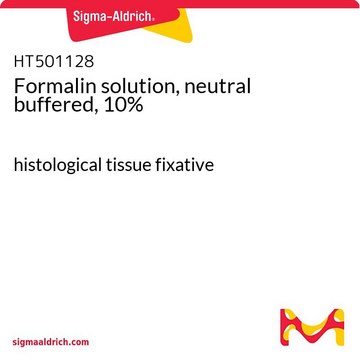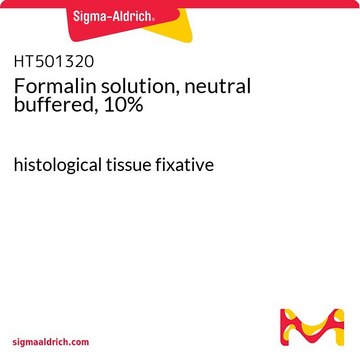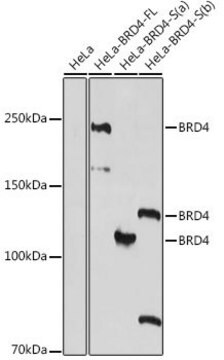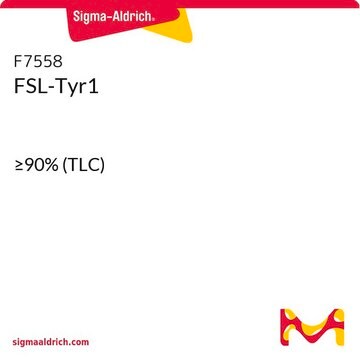ABE1451
Anti-phospho BRD4 (Ser492)
from rabbit
Sinonimo/i:
Bromodomain-containing protein 4, MCAP, Mitotic chromosome-associated protein, Protein HUNK1
About This Item
Prodotti consigliati
Origine biologica
rabbit
Livello qualitativo
Forma dell’anticorpo
affinity isolated antibody
Tipo di anticorpo
primary antibodies
Clone
polyclonal
Reattività contro le specie
mouse, human
Reattività contro le specie (prevista in base all’omologia)
rat (based on 100% sequence homology)
tecniche
dot blot: suitable
immunocytochemistry: suitable
western blot: suitable
N° accesso NCBI
N° accesso UniProt
Condizioni di spedizione
wet ice
modifica post-traduzionali bersaglio
phosphorylation (pSer492)
Informazioni sul gene
human ... BRD4(23476)
Descrizione generale
Specificità
Immunogeno
Applicazioni
Western Blotting Analysis: A 1:500 dilution from a representative lot detected Brd4 Ser493 (equivalent to human Ser492) phosphorylation in lysate from 12-day cultured E16.5 embryonic mouse cortical neurons. Prior phosphatase treatment of the lysate abolished target band detection (Courtesy of Erica Korb, Ph.D. Rockefeller University, New York, U.S.A.).
Dot Blot Analysis: A representative lot detected BRD4 phosphopeptide with pSer492 or dual pSer492/494 phosphorylation (equivalent to mouse Ser493/495), but not the corresponding non-phosphorylated peptide or peptide with only pSer494 phosphorylation (Korb, E., et al. (2015). Nat. Neurosci. 18(10):1464-1473).
Western Blotting Analysis: A representative lot detected Brd4 Ser493 (equivalent to human Ser492) phosphorylation induction upon BDNF stimulation of cultured E16.5 embryonic mouse cortical neurons from C57BL/6 mice. Pre-treatment of neurons with CK2 inhibitor 4,5,6,7-tetrabromobenzotriazole (TBB; Cat. No. 218697) before BDNF stimulation or phosphatase treatment of the lysate prior to immunoblotting abolished target band detection (Korb, E., et al. (2015). Nat. Neurosci. 18(10):1464-1473).
Epigenetics & Nuclear Function
Qualità
Western Blotting Analysis: A 1:1000 dilution of this antibody detected Brd4 Ser492 phosphorylation in 10 µg of human induced pluripotent stem cell (iPSC) lysate.
Descrizione del bersaglio
Stato fisico
Stoccaggio e stabilità
Altre note
Esclusione di responsabilità
Non trovi il prodotto giusto?
Prova il nostro Motore di ricerca dei prodotti.
Codice della classe di stoccaggio
12 - Non Combustible Liquids
Classe di pericolosità dell'acqua (WGK)
WGK 1
Punto d’infiammabilità (°F)
Not applicable
Punto d’infiammabilità (°C)
Not applicable
Certificati d'analisi (COA)
Cerca il Certificati d'analisi (COA) digitando il numero di lotto/batch corrispondente. I numeri di lotto o di batch sono stampati sull'etichetta dei prodotti dopo la parola ‘Lotto’ o ‘Batch’.
Possiedi già questo prodotto?
I documenti relativi ai prodotti acquistati recentemente sono disponibili nell’Archivio dei documenti.
Il team dei nostri ricercatori vanta grande esperienza in tutte le aree della ricerca quali Life Science, scienza dei materiali, sintesi chimica, cromatografia, discipline analitiche, ecc..
Contatta l'Assistenza Tecnica.








